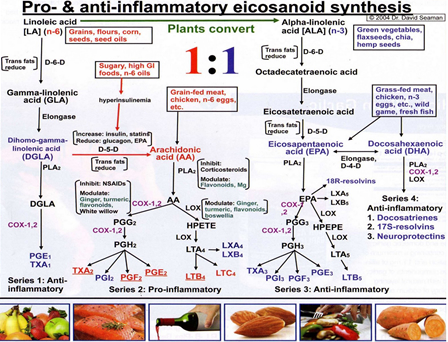|
 Frank Shallenberger, MD, HMD Frank Shallenberger, MD, HMD
Fish Oil
After last month's review of Brian Peskin's presentation on PEOs (parent essential oils) and his negative feelings about fish oils, let's consider the long history of positive data on fish oil. Shallenberger, in his NHIMA lecture, presented several studies in support of fish oil. Shallenberger is the author of several books on nutrition and oxygen utilization and is president of the American Academy of Ozonotherapy (www.aaot.us).
Pro- and anti-inflammatory eicosanoid syntheses are summarized in Figure 1 by Dr. David Seaman and are a little daunting for the average practitioner. Shallenberger notes that DHA (docosohexaenoic acid) constitutes almost half of all of the fats in the brain and that it is critically involved in every aspect of brain function. He asserts that DHA deficiencies are found in patients with cognitive disorders and in patients suffering from severe depression and that DHA is decreased by ALA (alpha-linolenic acid), the parent omega-3 EFA (essential fatty acid).

Souvenaid in Mild Alzheimer's Disease
Souvenaid, a product not yet available, contains EPA, DHA, choline, uridine monophosphate, B vitamins, and a mixture of antioxidants. In study by Scheltens et al. researchers enrolled 200 men and women with mild Alzheimer's disease for 6 months to be treated with Souvenaid or placebo.1 Assessments were made at baseline, 3 months, and 6 months with a neuropsychological test battery (NTB) and EEG. They found statistically valid improvement in both the NTB and EEG vs. no improvement in the placebo group. Placebos were switched to treatment and all followed for 2 more years. Memory scores on the NTB continued to improve and, according to the lead author, "There was no ceiling effect." Scheltens noted that the memory-enhancing effect of the supplement was as good as Aricept, Razadyne, and Exelon without the ceiling effects and side effects. Souvenaid contains 300 mg of EPA and 1200 mg of DHA. The usual ratio is 360 mg EPA to 270 mg DHA. Uridine monophosphate is found in high concentrations in beets and mother's milk and is essential for brain function, especially learning. Uridine is essential for the formation and protections of dendrites and axons and the production of phosphatidylcholine. Souvenaid contains 625 mg of uridine monophosphate, available from Ecological Formulas. Although this study does not purely involve omega-3 oils, it is an interesting approach to early Alzheimer's.
Serum Phospholipid Docosahexaenoic Acid Is Associated with Cognitive Functioning During Middle Adulthood
Shallenberger next presented a study by Muldoon et al. that measured the serum phospholipid docosahexaenoic acid and its association with cognitive functioning during middle adulthood.2 He notes that delta-6 desaturase converts ALA to EPA and DHA, and 10% to 25% of those living in industrial nations don't have adequate delta-5 desaturase activity. The study measured the ALA, EPA, and DHA blood levels in 280 mentally healthy men and women between ages 35 and 54 and did cognitive testing for nonverbal reasoning, mental flexibility, working memory, and vocabulary. ALA and EPA levels did not correlate with cognitive function but DHA blood levels linearly correlated with cognitive function. Educational level was irrelevant. The higher the DHA levels, the better the scores. "Only DHA is associated with major aspects of cognitive performance." Delta-5 and delta-6 desaturase enzyme activity (responsible for several conversions of LA and ALA down the synthesis cascade of eicosanoids) and are blocked by nutritional deficiencies of zinc, magnesium, selenium, B complex, and vitamin C as well as linoleic acid, saturated fat, trans fats, alcohol, monounsaturated fats (such as olive, canola, and peanut oil), inflammation, hyperglycemia, hypothyroidism, hypercholesterolemia, protein deficiency, insulin resistance, oxidative stress, aging, genetics, and caffeine.
Fish Intake and Risk of Incident Atrial Fibrillation
Mozaffarian et al. completed a study of 4815 adults all older than 65 years, which monitored fish oil intake for 12 years as well as serum DHA and EPA.3 None were on supplements. They found that the omega-3 levels were highest in tuna and non-fried fish. Fried fish had no increase in serum levels and contained the least omega-3s. Frying added omega-6s.
In the study 980 of the group (20%) developed atrial fibrillation. Eating fish from 1 to 4 times per week gave 28% fewer cases than eating fish once per month. Eating fish 5 times per week had the highest omega-3 levels and 31% fewer cases of atrial fibrillation. The authors point out that taking fish oil supplements has been shown to lower blood pressure, reduce systemic inflammation, improve circulation, improve heart function, decrease dangerous arrhythmias, and decrease the excitability of heart cells. They comment that when atrial heart tissue is induced in laboratory experiments to develop the kind of irregular activity that leads to atrial fibrillation, it is much less likely to develop that activity if it is exposed to fish oils beforehand.
Schallenberger noted that there were 2046 abstracted, peer-reviewed citations of fish oil supplements in PubMed. He was unimpressed with any data supportive of South American calamari oil and mentioned several studies that have shown toxic residues in Antarctic krill oil. The "established benefits of fish oils supps": lowers triglycerides, decreases platelet adhesion, decreases inflammation and CRP, improves peripheral blood flow in diabetics, increases HDL cholesterol, and clinically improves CHF.4
Association of Marine Omega-3 Fatty Acid Levels with Telomeric Aging in Patients with Coronary Heart Disease
From the Division of Cardiology at San Francisco General Hospital, researchers found that higher intakes of omega-3 fatty acids increase life expectancy in patients with heart disease.5 They also knew that patients with heart disease have much shorter telomeres than people with healthy hearts. The study looked at 608 patients with stabilized coronary artery disease. They measured telomere length and omega-3 fatty acids levels. Six years later they remeasured the patients and found that all patients had shorter telomeres, all "in the normal range." Patients in the lowest quartile omega-3 levels shortened 3 times more than those in the highest quartile. "The present findings identify deceleration of telomere attrition as a potentially novel pathway for the anti-aging effects of marine omega-3 fatty acids."
Ornish et al. noted that healthy diet, regular exercise, and 3 grams daily of concentrated fish oil significantly increased telomerase activity.6
Long-Term Intake of Fish Oil Increases Oxidative Stress and Decreases Lifespan in Senescence-Accelerated Mice
Tsuduki et al. studied mice that age at an accelerated rate (1-year lifespan) and show the same learning and memory devicits, increase in anxiety, and immune system impairment commonly seen in aging humans.7 The mice were fed a 10% safflower oil diet or 5% safflower oil diet with 5% fish oil from birth until death. The safflower oil mice lived an average of 56.3 weeks and the fish oil group lived an average of 48.4 weeks. In human terms it would correlate to a 72-year life expectancy compated with a 61-year lifespan.
Conclusions: safflower oil is healthier? Dose doesn't matter? Cradle to grave intake doesn't matter? Shallenberger comments that caloric intake for his height and weight is about 1800 calories per day. A 5% fish oil diet would equal 90 calories or about 10 grams of fish oil per day coming from about 15 capsules of concentrated fish oil per day. This would be a toxic dose if he were to consume this every day of his life. Atlantic salmon has the highest levels of omega-3 of any fish commonly eaten in the US. For him to reach to toxic level of fish oils consumed by the now deceased mice in this study, he would have to eat 7.5 pounds of salmon every month for the rest of his life.
What Killed the Mice?
Phospholipid hydroperoxides and TBARS (thiobarbituric acid reactive substances), formed as a byproduct of lipid peroxidation (i.e., as degradation products of fats), which can be detected by the TBARS assay using thiobarbituric acid as a reagent, were 200% greater in the fish oil supplemented mice. Good evidence that the mice died from accelerated aging secondary to excessive free radical stress. The chow fed the mice was left out and exposed all day to oxygen. Omega-3 fats are more rapidly oxidized than omega-6 fats. Shallenberger's moral: Don't eat more than 14 capsules of concentrated fish oil per day that have been exposed all day to the air.
How To Kill Oils
Below are typical steps that a food processor uses to make commercial cooking oils such as those that at local supermarkets and restaurants. It's nearly impossible to completely avoid them. Most of the omega-6 oils are damaged during processing. Soybean, corn, and canola oils are all predominantly omega-6 oils, and most are highly processed and oxidized, which may have caused them to have bad effects in scientific and epidemiological studies.
Typical Processing for Cooking Oils8
- Start with seeds, nuts, beans
- wash
- squash or mash
- solvent soak (hydrocarbon solvent such as hexane)
- remove solids (boil off at approximately 300 oF)
- mix with water to separate gum
- spin to remove gum
- add akali (such as lye, used in drain cleaner) and mix well
- spin to remove particles
- bleach at 230 oF
- filter
- steam treat at 450 oF and vacuum
- chill and filter
- add preservatives and antifoam agent (silicone)
- package
It seems impossible that any oil wouldn't sustain grave molecular damage at these high temperatures.
Dr. Gordon Conversation
A happenstance phone call from Gary Gordon, DO, MD, MD(H), pillar of innovation in chelation, nutrition, homeopathy, and much more reminded me of the book The Cardiologist's Omega-3 Diet, which he coauthored with Nate Lebowitz, MD, and Herb Joiner-Bey, ND.9 It reviewed several hundred studies on fish oils and omega-3s. This book contained some mixed outcome studies and covered many aspects of physical and mental health. It will be interesting to see if the 2 to 1 omega-6 to omega-3 fatty acids ratio using nondamaged, organic vegetable oils á la Peskin will prove to be as beneficial or more powerful than fish oil in preventing and treating disease.

Notes
1. Scheltens P, Twisk JW, Blesa R et al. Efficacy of Souvenaid in mild Alzheimer's disease: results from a randomized, controlled trial. J Alzheimers Dis. 2012; 31:225–236.
2. Muldoon MF et al. Serum phospholipid docosahexaenonic acid is associated with cognitive functioning during middle adulthood. J Nutr. 2010 Apr;140(4):848–853.
3. Mozaffarian D, Psaty B, Rimm EB, et al. Fish intake and risk of incident atrial fibrillation. Circulation. 2004 July 27; 1104): 368–373.
4. Brinson BE, Miller S. Fish oil: what is the role in cardiovascular health? J Pharm Pract. 2011 Jun 6.
5. Farzaneh-Far R, Lin J, Epel ES, Harris WS, Blackburn EH, Whooley MA. Association of marine omega-3 fatty acid levels with telomeric aging in patients with coronary heart disease. 2010 Jan 20;303(3):250–257. doi:10.1001/jama.2009.2008.
6. Ornish D et al. Increased telomerase activity and comprehensive lifestyle changes: a pilot study. Lancet Oncol. November 2008;9(11):1048–1057
7. Tsuduki T et al. Long-term intake of fish oil increases oxidative stress and decreases lifespan in senescence-accelerated mice. Nutrition. 2011 Mar;27(3):334–337.
8. Your Essential Supplements Inc. [Web page]. www.Yes-supplements.com.
9. Lebowitz N, Gordon G, Joiner-Bey H. The Cardiologist's Omega-3 Diet. Freedom Press; 2007.
Michael Gerber, MD, HMD
contact@gerbermedical.com
Conference videos are available from Tiffany: info@nevadahomeopathy.org.
|
![]()
![]()
![]()





 Frank Shallenberger, MD, HMD
Frank Shallenberger, MD, HMD